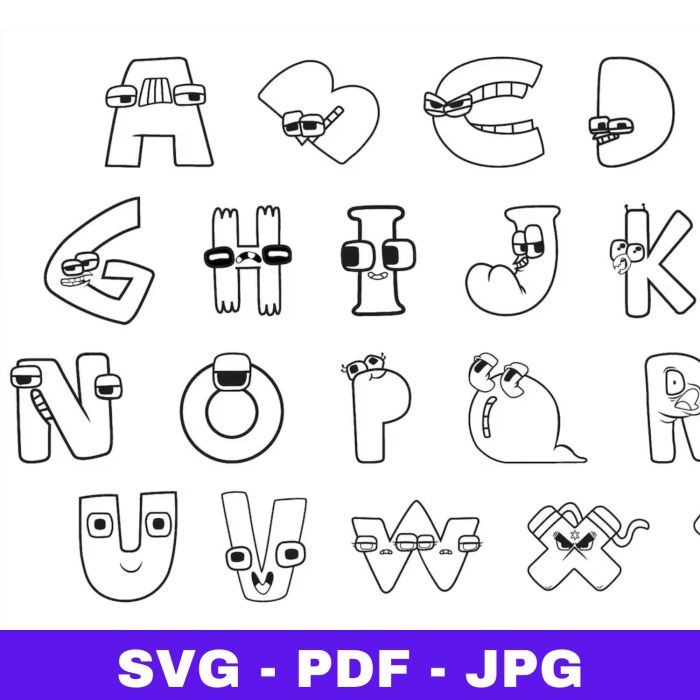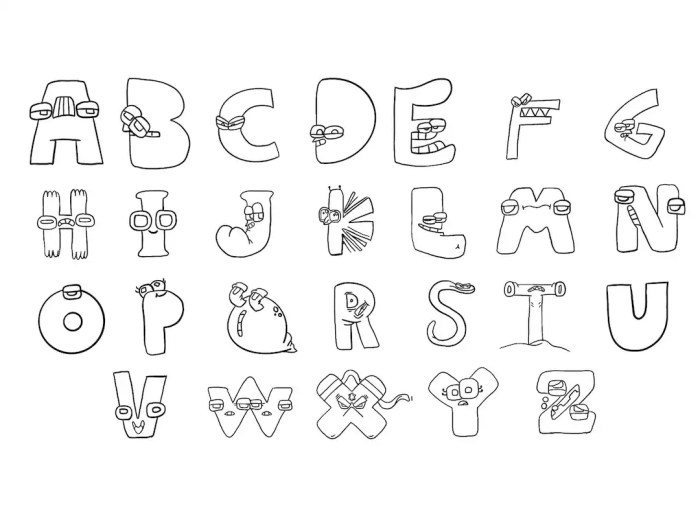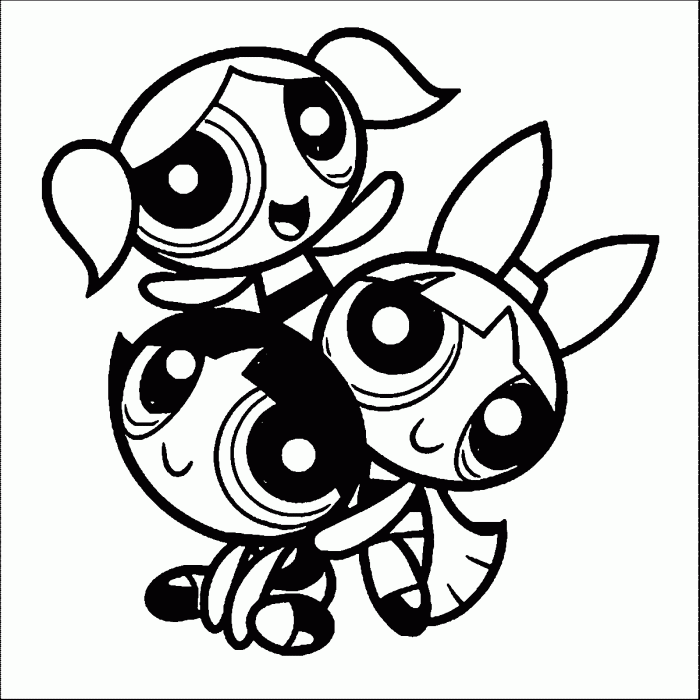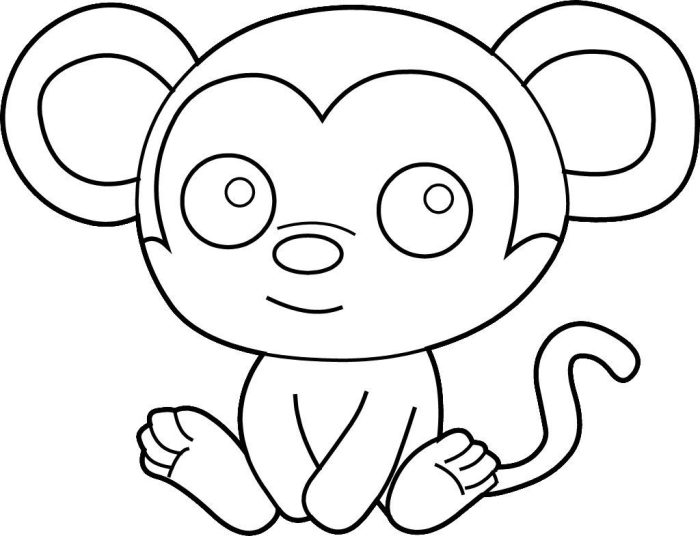Illustrations and Visual Style

A successful Alphabet Lore coloring book requires a visual style that captures the essence of the source material while remaining engaging and accessible for young children. The illustrations should be appealing, easy to color, and visually stimulating without being overly complex. The chosen style should also be consistent throughout the book, creating a cohesive and enjoyable experience for the user.The artistic style should be predominantly cartoonish.
This choice is justified because a cartoonish style allows for expressive character designs and simplified forms, making the images easier for children to understand and color. The exaggerated features and playful proportions inherent in cartoon art will resonate with the target audience and complement the playful nature of Alphabet Lore. A realistic style would be too detailed and potentially intimidating for young colorists, while a minimalist approach might lack the visual appeal necessary to hold children’s attention.
Alphabet Lore coloring books offer a fun way for children to learn letters and colors. Expanding on this theme, you might also find inspiration in resources like this collection of coloring book sheets sinking swimming floating inspirational designs, which explore similar concepts of buoyancy and density in a creative visual way. These could even spark ideas for creating your own Alphabet Lore themed pages, adding another layer of learning and fun.
Line Weight and Style
The line weight should be relatively thick, approximately 3-5 points, to ensure that the lines are clearly visible and easy for children to follow when coloring. Thinner lines could be easily lost or smudged during the coloring process. The line style should be clean and smooth, avoiding overly intricate or jagged lines that would be difficult to color within.
A simple, consistent line weight will enhance the clarity of the images and make the coloring experience more straightforward. This will also prevent frustration for younger children who may struggle with finer details.
Techniques for Creating Visual Interest, Alphabet lore coloring book
Several techniques can be employed to create visual interest without overwhelming the coloring pages. Simple patterns within shapes, such as stripes or polka dots, can add visual texture and appeal. These patterns should be simple and repetitive to avoid excessive complexity. Strategic use of positive and negative space can also create visual dynamism. Leaving some areas uncolored or incorporating simple background elements can guide the eye and make the coloring pages more engaging.
Furthermore, incorporating simple, yet varied textures (e.g., a slightly rough texture for a stone wall) can add visual richness without increasing coloring difficulty. Avoid using highly detailed textures or patterns that could overwhelm children.
Background Scene Descriptions
Three different background scenes that would enhance the coloring pages while maintaining the Alphabet Lore aesthetic are: A vibrant, whimsical classroom: This setting could feature simple, colorful desks, chairs, and perhaps a blackboard with playfully drawn equations or letters. The colors could be bright and cheerful, reflecting the playful nature of the Alphabet Lore characters.
-
2. A fantastical forest setting
This background could feature stylized trees with simple, rounded shapes and whimsical flowers. The trees could be various bright colors, and the flowers could have simple, easily colorable patterns. This setting would provide a contrast to the classroom setting and allow for greater creativity.
- A surreal, geometric landscape: This background could incorporate simple geometric shapes and patterns, echoing the letter-based nature of Alphabet Lore. The shapes could be various sizes and colors, and the overall effect should be playful and visually engaging without being overwhelming. This option provides a modern and abstract alternative.
Additional Features and Considerations

Enhancing the Alphabet Lore coloring book beyond simple coloring pages requires careful consideration of additional features that will increase its appeal and educational value for young children. Adding bonus content and interactive elements can transform it from a passive activity into an engaging and stimulating experience. This section details several options to enrich the coloring book.
Bonus Content
Including bonus content significantly increases the perceived value and playtime of the coloring book. Stickers featuring the Alphabet Lore characters are a popular choice, offering a tactile element and allowing children to personalize their creations. A short story, perhaps a simple adventure featuring the characters, could complement the coloring pages, providing a narrative context and further engaging the child’s imagination.
Simple activities like connect-the-dots puzzles or mazes using Alphabet Lore imagery can add another layer of fun and educational value, promoting fine motor skills and problem-solving abilities. A sticker sheet featuring the alphabet characters could also serve as a supplementary learning tool.
Interactive Elements
Interactive elements elevate the coloring book beyond a static activity. Hidden objects within the illustrations, subtly incorporated into the artwork, encourage careful observation and attention to detail. Mazes featuring the Alphabet Lore characters can provide a fun challenge, improving spatial reasoning and problem-solving skills. Simple “find the differences” activities comparing two nearly identical images of Alphabet Lore scenes can add an element of visual comparison.
These elements enhance engagement and extend the playtime significantly.
Paper Type Comparison
The choice of paper significantly impacts the coloring experience and the overall quality of the coloring book. Different paper types offer varying levels of cost, durability, and coloring performance.
| Paper Type | Cost | Durability | Coloring Experience |
| Standard Printer Paper | Low | Low; prone to tearing and bleed-through | Can be prone to feathering and smudging, especially with water-based markers. |
| Cardstock | Medium | High; less prone to tearing | Provides a smoother surface for coloring, minimizing feathering. More resistant to bleed-through. |
| Drawing Paper | Medium-High | High; durable and resistant to tearing | Excellent surface for a wide variety of coloring mediums; minimal bleed-through. |
| Specialty Coloring Book Paper | High | High; thick and durable | Designed specifically for coloring; minimizes bleed-through and feathering, even with markers. |
Age Appropriateness and Safety
Age appropriateness and safety are paramount in designing a children’s coloring book. Illustrations should be age-appropriate, avoiding anything that could be considered frightening or disturbing to young children. The use of non-toxic inks and paints is crucial to ensure the safety of children who may put the coloring book in their mouths. Sharp edges or small parts should be avoided to prevent choking hazards.
The paper should be sturdy enough to withstand the use by young children, reducing the risk of tears and ingestion of small pieces of paper. The overall design should prioritize safety and encourage creativity in a safe and stimulating environment. For example, sharp points on characters should be avoided, and all illustrations should be simple and easily understood.
Pricing and Production: Alphabet Lore Coloring Book
Producing a high-quality Alphabet Lore coloring book requires careful consideration of pricing and production strategies to ensure profitability while maintaining an appealing product for consumers. This involves analyzing competitor pricing, selecting appropriate printing methods, and meticulously planning the production process.Pricing strategies for similar children’s coloring books vary significantly depending on factors such as brand recognition, book size, page count, paper quality, and the inclusion of additional features (e.g., stickers, stencils).
A simple 20-page coloring book featuring basic illustrations might retail for $5-$8, while a larger, more elaborate book with higher-quality paper and additional features could command a price of $12-$20 or more. For example, “The Very Hungry Caterpillar” coloring book, due to its brand recognition and quality, sits at the higher end of this spectrum, while generic alphabet books might be found at the lower end.
Printing Methods and Cost Analysis
Offset printing is generally the most cost-effective method for large print runs (1000+ copies), offering superior color accuracy and image sharpness. However, the initial setup costs can be high. Digital printing, while more expensive per unit for large runs, is ideal for smaller print runs or for personalized coloring books, as it eliminates the need for printing plates. For a high-quality coloring book like the Alphabet Lore one, offset printing would likely be the most suitable choice for a print run of 1000 copies, balancing cost-effectiveness with the desired print quality.
Production Process
The production process involves several key steps:
1. Design Finalization
This includes finalizing all illustrations, ensuring color accuracy, and preparing the artwork for printing.
2. Pre-press
This stage involves preparing the files for printing, creating printing plates (for offset printing), and checking for any errors.
3. Printing
The actual printing of the coloring book pages using the chosen method (offset or digital).
4. Binding
This involves collating the printed pages and binding them together, typically using saddle-stitch binding (stapling) for a coloring book of this type.
5. Quality Control
A thorough inspection of the finished products to identify and rectify any defects.
6. Packaging and Distribution
Packaging the books for shipping and distribution to retailers or directly to consumers.
Hypothetical Budget Breakdown (1000 copies)
This budget is a hypothetical example and may vary based on specific choices made during the production process. It assumes offset printing is used.
| Cost Item | Estimated Cost (USD) |
|---|---|
| Design & Illustration (including revisions) | $1500 |
| Pre-press & Printing Plates (Offset) | $800 |
| Printing (1000 copies) | $2000 |
| Binding & Finishing | $500 |
| Packaging & Materials | $200 |
| Shipping & Handling | $300 |
| Contingency (10%) | $500 |
| Total Estimated Cost | $6000 |
Note: This budget is an estimate. Actual costs may vary depending on the chosen suppliers, print specifications, and unforeseen circumstances.


